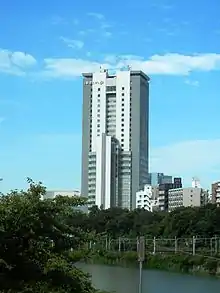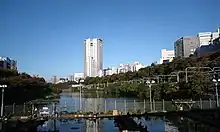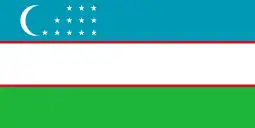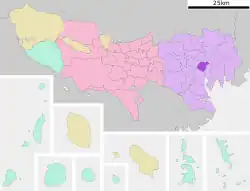法政大学 | |
 | |
| Type | Private |
|---|---|
| Established | 1880 |
| President | Yuko Tanaka (田中優子, Tanaka Yūko) |
Academic staff | 746[1] |
| Undergraduates | 28,000[1] |
| Postgraduates | 2,007[1] |
| Location | , |
| Campus | Urban and suburban |
| Colors | Orange and blue |
| Website | hosei.ac.jp |
 | |
Hosei University (法政大学, Hōsei Daigaku, lit. University of Law and Politics) is a private research university in Yotsuya, Tokyo, Japan.
The university originated in a school of law, Tōkyō Hōgakusha (東京法学社, i.e. Tokyo association of law), established in 1880, and the following year renamed Tōkyō Hōgakkō (東京法学校, i.e. Tokyo school of law). This was from 1883 headed by Dr. Gustave Boissonade, and was heavily influenced by the French legal tradition. It merged in 1889 with a school of French studies, Tōkyō Futsugakkō (東京仏学校, i.e. Tokyo French school), that had been founded three years earlier. It adopted the name Hosei University (法政大学, Hōsei daigaku, i.e. university of law and politics) in 1903 and was recognized as a private university in 1920.
Other notable figures involved in its foundation include Dr. Masaaki Tomii, and Dr. Ume Kenjirō, "Father of the Japanese Civil Code".
Hosei University is popularly regarded as comparable with the Tokyo-area elite selective private universities Meiji, Aoyama Gakuin, Rikkyo, and Chuo, collectively known as "MARCH". It has an entrance examination difficulty level that is in the top 10 for a private university in Japan.[2]
In addition, Hosei University belongs to Tokyo Big6 Baseball League. The league is one of the most traditional college sports leagues in Japan. Hosei University is popular for high school students, ranking 2nd in the number of applicants among Japanese universities in 2017 and 2018 (122,499). Hosei University ranked 100 at Global Executives 2013 top 100 by The Times Higher Education.
Hosei has three main campuses, which it calls Ichigaya, Koganei, and Tama. The Ichigaya campus is an urban campus halfway between Ichigaya and Iidabashi stations in central Tokyo; its 26-story Boissonade Tower, completed in 2000, can be seen from either station. The campus has a city flavour but is still somewhat isolated from central Tokyo; it is located in the vicinity of the Yasukuni Shrine.
Natural sciences are studied at the Koganei campus to the west of Tokyo, and other subjects are split between Tama (located in Machida, which is near Hachiōji), and Ichigaya.
Academics
Ichigaya


Undergraduate
- Faculty of Law (法学部, Hōgakubu)
- Faculty of Letters (文学部, Bungakubu)
- Faculty of Business Administration (経営学部, Keieigakubu)
- Faculty of Intercultural Communication (国際文化学部, Kokusai-bunka-gakubu)
- Faculty of Sustainability Studies (人間環境学部, Ningen-kankyō-gakubu)
- Faculty of Lifelong Learning and Career Studies (キャリアデザイン学部, Kyaria-dezain-gakubu)
- Faculty of Engineering and Design (デザイン工学部, Dezain-kōgakubu)
- Faculty of Global and Interdisciplinary Studies (GIS, グローバル教養学部, Gurōbaru-kyōyō-gakubu) (from 2008)
- Sports Science Institute (SSI, スポーツサイエンスインスティテュート, Supōtsu-saiensu-insutityūto)
Graduate schools
- Graduate School of Humanities (人文科学研究科, Jinbun-kagaku-kenkyūka)
- Graduate School of Economics (経済学研究科, Keizaigaku-kenkyūka)
- Graduate School of Law (法学研究科, Hōgaku-kenkyūka)
- Graduate School of Politics (政治学研究科, Seijigaku-kenkyūka)
- Graduate School of Sociology (社会学研究科, Shakaigaku-kenkyūka)
- Graduate School of Business Administration (経営学研究科, Keieigaku-kenkyūka)
- Graduate School of Policy Sciences (政策科学研究科, Seisaku-kagaku-kenkyūka)
- Graduate School of Environmental Management (環境マネジメント研究科, Kankyō-manejimento-kenkyūka)
- Graduate School of Intercultural Communication (国際文化研究科, Kokusai-bunka-kenkyūka)
- International Japan-Studies Institute (国際日本学インスティテュート, Kokusai-nihongaku-insutityūto)
- Law School (法科大学院, Hōka-daigakuin)
- Business School of Innovation Management (イノベーション・マネジメント研究科, Inobēshon-manejimento-kenkyūka)
Tama
- Faculty of Economics (経済学部, Keizaigakubu)
- Faculty of Social Sciences (社会学部, Shakaigakubu)
- Faculty of Social Policy and Administration (現代福祉学部, Gendai-fukushi-gakubu)
- Graduate School of Social Well-Being Studies (人間社会研究科, Ningen-shakai-kenkyūka)
Koganei
- Faculty of Engineering (工学部, Kōgakubu) (being phased out)
- Faculty of Science and Engineering (理工学部, Rikōgakubu) (from 2008)
- Faculty of Bioscience and Applied Chemistry (生命科学部, Seimeikagakubu) (from 2008)
- Faculty of Computer and Information Science (情報科学部, Jōhōkagakubu)
- Graduate School of Engineering (工学研究科, Kōgaku-kenkyūka)
- Graduate School of Computer and Information Science (情報科学研究科, Jōhōkagaku-kenkyūka)
Notable Alumni
Academia
- Sadayoshi Fukuda, philosopher and critic[3]
Politics
- Yoshihide Suga, the 99th Prime Minister of Japan
- Kazunori Tanaka, Diet representative, Minister of Reconstruction (2019-2020)
- Kosuke Ito, Diet representative[4]
- Hideo Jinpu, Diet representative[5]
- Yukio Jitsukawa, Diet representative[6]
- Emi Kaneko, Diet representative[7]
- Taku Yamamoto, Diet representative
- Yoshio Yatsu, Diet representative
- Shinpei Matsushita, Member of the House of Councillors[8]
Athletes
- Yukihiro Doi, racing cyclist
- Takuya Honda, football player[9]
- Kairi Hojo, professional wrestler[10]
- Takayuki Mikami, karateka
- Kyohei Morita, rugby player
- Yuka Sato, figure skater
- Tadashi Wakabayashi, baseball player
- Nishida Hiroki, Volleyball Player[11]
Arts and Entertainment
- Mizuhito Akiyama, author[12]
- Chiho Aoshima, artist[13]
- Mew Azama, model and actress[14]
- Satoshi Dezaki, anime director
- Shu Fujisawa, author[15]
- Tomoko Hoshino, actress[16]
- Norihiro Inoue, actor
- Mitsuaki Iwagō, photographer[17]
- Hiroh Kikai, photographer[18]
- Shin Kishida, actor*
- Hiroto Kōmoto, singer*
- Aki Maeda, actress
- Masao Maruyama, film producer
- Michiko Matsumoto, photographer[19]
- Katsuhito Nakazato, photographer[20]
- Kinoko Nasu, author
- Kouhei Kadono, author[21]
- Midori Sawato, film narrator
- Haruka Takachiho, author
- Yōsuke Yamahata, photographer*[22]
- Shuichi Yoshida, novelist
- Yasumi Matsuno, video game creator*
- Shōgo Yano, voice actor
Other
- Kenji Goto, journalist and writer
- Masahiro Hara, engineer
- Hu Han Min, Chinese Kuomintang politician
* dropped out before graduation
Notable Faculty
- Sadateru Arikawa
- Faubion Bowers
- Shu Fujisawa[23]
- Sadayoshi Fukuda[3]
- Kojin Karatani
- Shunji Karube
- Kiyozō Kazama
- Ume Kenjirō
- Ōmi Komaki
- Taro Kono
- Samezō Kuruma
- Ryokichi Minobe
- Shūmei Ōkawa
- Mitsukuri Rinsho
- Ishimoda Shō
- Fujisawa Shu
- Morita Sōhei
- Hiroshi Takahashi
- Jūji Tanabe
- Hyakken Uchida
- Tetsuro Watsuji
Sports
The university's baseball team plays as one of the Tokyo Big6 Baseball League.
Partner universities
 United States
United States
- Boston University
- Baylor University
- University of California, Davis
- University of California, San Diego
- Michigan State University
- California State University, East Bay
- Truman State University
- University of Nevada, Reno
- Boise State University
- San Jose State University
- Fontbonne University
- San Diego State University
- Southern California Institute of Architecture
- University of Illinois
- Gustavus Adolphus College
- West Chester University of Pennsylvania
- University of Wisconsin–Milwaukee
- Minnesota State University, Mankato
- Medaille College
- Portland State University
- Westfield State University
- University of Utah
- George Mason University
 China
China
- Peking University
- School of Government, Peking University
- School of Humanities and Social Sciences, Tsinghua University
- School of Social Sciences, Tsinghua University
- University of Science and Technology of China
- Shanghai Jiao Tong University
- Wuhan University
- Xiamen University
- University of Science and Technology Beijing
- Beijing Normal University
- Capital Normal University
- Shanghai International Studies University
- Northeastern University (China)
- State Administration of Foreign Experts Affairs
- Chongqing Normal University
- China Foreign Affairs University
- Xi'an Jiaotong University
- Beijing Jiaotong University
- Beijing Foreign Studies University
- Minzu University of China
- Beijing Center for Japanese Studies
- Shandong University of Finance and Economics
- Dalian Nationalities University
- Sichuan International Studies University
- Liaoning University, College of International Relations
- Fuzhou University
- Dalian University of Foreign Languages
- Software College of Jilin University
- Xidian University
- Huazhong University of Science & Technology
- School of Software, Central South University
 India
India
 Indonesia
Indonesia
 Uzbekistan
Uzbekistan
 South Korea
South Korea
- Yonsei University
- Duksung Women's University
- Sungkonghoe University
- Seoul National University
- Gachon University
- Korea University
- University of Seoul
- Ewha Womans University
- Inha University
- Sungshin Women's University
- Hankuk University of Foreign Studies
- Chung-Ang University
- Konkuk University
- Kyonggi University
- Busan University of Foreign Studies
- Hoseo University
 Thailand
Thailand
 Ethiopia
Ethiopia
 Russia
Russia
 Algeria
Algeria
 United Kingdom
United Kingdom
- Royal Holloway, University of London
- University of Sheffield
- University of Reading
- The University of Nottingham
- University of Glasgow
- University of Leeds
- Newcastle University
- University of Sussex
- University of Bradford
- The University of York
- Birkbeck, University of London
- University of Wolverhampton
.svg.png.webp) Australia
Australia
 New Zealand
New Zealand
.svg.png.webp) Canada
Canada
 Ireland
Ireland
 Vietnam
Vietnam
- Ho Chi Minh City University of Technical Education
- University of Social Sciences and Humanities - VNU
 Taiwan
Taiwan
- National Sun Yat-sen University
- Tamkang University
- Wenzao Ursuline University of Languages
- Chung Yuan Christian University
- National Formosa University
- National Yunlin University of Science and Technology
- National Kaohsiung Normal University
- Shih Chien University
- National Taiwan Normal University
- National Chengchi University
 Cambodia
Cambodia
 Laos
Laos
 Malaysia
Malaysia
 Italy
Italy
 Austria
Austria
.svg.png.webp) Switzerland
Switzerland
 Spain
Spain
 Czech Republic
Czech Republic
 Germany
Germany
 Hungary
Hungary
 France
France
 Argentina
Argentina
 Mexico
Mexico
References
- 1 2 3 Rounded to the nearest hundred from information given on this page Archived 2008-12-11 at the Wayback Machine (in Japanese) of the university website, which gives information for May 1, 2008. Accessed 2008-11-16.
- ↑ "法政大学の偏差値・難易度". Archived from the original on 2021-10-21. Retrieved 2022-02-06.
- 1 2 Hyōronka jinmei-jiten (評論家人名事典) / Japanese critics and commentators: A biographical dictionary (Tokyo: Nichigai Associates, 1990; ISBN 4-8169-1002-6).
- ↑ Profile Archived 2014-12-31 at the Wayback Machine on Ito's website. Retrieved September 13, 2010.
- ↑ Profile Archived 2011-07-22 at the Wayback Machine on Jinpu's website. Retrieved September 13, 2010.
- ↑ Profile on Jitsukawa's website. Retrieved September 13, 2010.
- ↑ Profile on Kaneko's website. Retrieved September 13, 2010.
- ↑ Profile Archived 2021-12-16 at the Wayback Machine on Matsushita's website. Retrieved September 13, 2010.
- ↑ Page about Honda Archived 2009-03-30 at the Wayback Machine, Hosei University. Retrieved September 7, 2010.
- ↑ Hojo's profile on Horipro agency's website. Retrieved June 3, 2016.
- ↑ "西田 寛基 サントリーサンバーズ".
- ↑ Mizuhito Kanehara, "Watakushi to toshokan (?)," Haru dayori 44 Archived 2012-03-06 at the Wayback Machine April 2004. Retrieved September 6, 2010.
- ↑ Profile at Kaikai Kiki Archived 2010-08-16 at the Wayback Machine. Retrieved September 6, 2010.
- ↑ Event announcement, Hosei University. Retrieved September 6, 2010.
- ↑ Interview with Fujisawa, Mainichi Shimbun. Retrieved September 7, 2010.
- ↑ Profile of Hoshino Archived 2010-07-25 at the Wayback Machine at "Atelier Duncan" agency. Retrieved September 9, 2010.
- ↑ Potted biography Archived 2011-07-26 at the Wayback Machine of Iwagō, Illume, Tepco. (in Japanese) Accessed 2010-09-02.
- ↑ Profile of Kikai, Fujifilm, 2007. (in Japanese) Accessed 2010-09-02.
- ↑ Page about Matsumoto at Toki no Wasuremono. (in Japanese) Accessed 2010-09-26.
- ↑ Nakazato's profile Archived 2007-10-24 at the Wayback Machine at Tokyo Zokei University. (in Japanese) Accessed 2010-09-03.
- ↑ Kadono Kouhei's Interview(Japanese Page) at Anima Solaris. (in Japanese) Accessed 2016-11-14.
- ↑ Profile of Yamahata, JPS. (in Japanese) Accessed 2010-09-02.
- ↑ Profile Archived 2009-06-15 at the Wayback Machine at Hosei. Retrieved September 7, 2010.
External links
- (in Japanese) Official site
- Official site
- History of Hosei University
